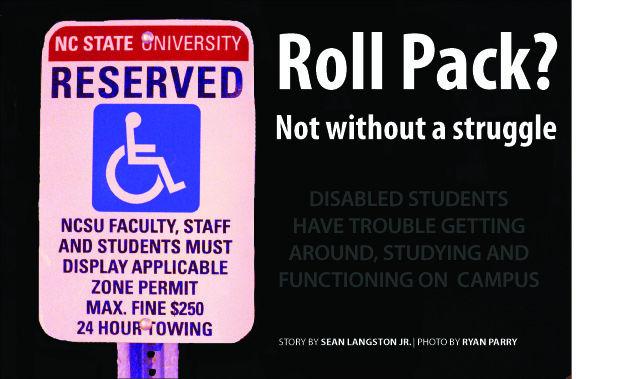
C.J. Leslie may have been able to lift Will Privette into the air two weeks ago after he stormed the court in his wheelchair, but Leslie’s busy schedule won’t allow him to do it every day.
Senior in communication Privette and other students with disabilities requiring mobility equipment are neglected in some areas of campus when they need to travel above the ground floor.
University Housing admits that wheelchair accessibility around campus is not optimal.
“I remember visiting a friend in Owen Hall, but my friend’s room wasn’t on the first floor, so I had to be toted up the stairs by a few people,” Privette said.
Privette expressed frustration with the lack of accessibility in certain areas of campus, specifically dorms.
“It’s unfortunate because people with wheelchairs can see how certain areas are difficult to access so much better than those without wheelchairs,” Privette said.
The list of dorms with minimal wheelchair accessibility is more extensive than you would expect: Bragaw, Lee, Sullivan, Owen, Tucker, Gold, Syme, Welch, Turlington, Alexander and Wood halls all limit wheelchair users.
A student who prefers to remain unnamed has expressed anger with the lack of handicap accommodations available at her dorm.
“I have a close family member who has wanted to visit my dorm room at Bragaw for the longest time, but she can’t because it’s on the second floor,” she said.
The student says she feels guilty for living in a dorm where there are only stairs, but she leaves the majority of the blame with University Housing for neglecting to have a wheelchair ramp or elevator.
Susan Grant, director of University Housing, explains that although funds to make housing renovations have been located, the staff has not fit the cost of elevators for Bragaw Hall into the budget. According to Grant, future renovation is projected to take place 10 years out.
Lee and Sullivan halls have elevators, but to students in wheelchairs, ascending to higher floors is not the problem.
An elevator provides access to each floor, but the elevator exit leads to two flights of stairs, which are the only paths to reach the dorm rooms. Students in wheelchairs cannot safely navigate these flights of stairs without assistance.
Pete Fraccaroli, University Housing Facilities Manager, admits when Sullivan and Lee were first built wheelchair accessibility was not in mind.
Grant says stories like these have prompted her staff to look at wheelchair accessibility much closer, but confesses that planning will be long term.
“We plan to make changes to Lee and Sullivan Hall in the next 10 to 12 years, and our University construction will make sure everything is ADA (Americans with Disabilities Act) appropriate, but right now, it’s a quandary,” Grant said.
Privette spent his first year at N.C. State living in University Towers and said the living circumstances offered there attracted him.
“UT was the perfect place for someone in a wheelchair, honestly,” Privette said.
He now resides in an off-campus apartment complex where necessary accommodations are provided with ease.
Privette’s frustration also encompasses what he calls “the lack of handicap parking offered” on campus. He recalls many instances where he was tardy and even missed classes because he was forced to park far away from his lecture halls.
“It frustrates me a lot because I don’t want special treatment, but they don’t need to make it any harder,” Privette said.